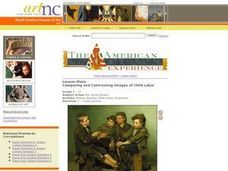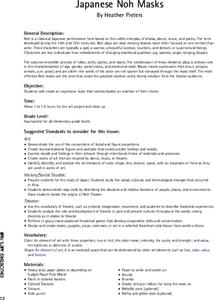Curated OER
September 11-How Do You Feel?: Terrorism, US History
Students have the opportunity to express their feelings and discuss their perceptions of the events of September 11, 2001. This could also be adapted to other crisis and disasters.
Curated OER
Growing Independence and Fluency Design: Express Yourself!
Second graders practice reading with expression. After discussing how reading with feeling and excitement can enhance the text, 2nd graders listen as the teacher reads a story with and without emotion. Individual students practice...
Curated OER
Sixth Graders Express Themselves
Sixth graders demonstrate an understanding of expressionism by creating a portrait of a friend who inspires a mood or feeling.
Curated OER
Express Yourself!
Students read aloud with expression through practice by monitoring their changes in volume, speed, and pitch of their voices. They use cross checking, if they come to a word they are unfamiliar with, they read the rest of the sentence....
Curated OER
Lesson: Text Messages
Can a neon sign be considered art? Kids consider two different works that use neon text as the basis for conveying artistic social messages. They then analyze a truism from Jenny Holzer's web site that holds meaning to them personally....
Curated OER
What If?
Second graders read WHAT IF? up to the page that ends "Suddenly, across the field they saw..." and discuss how the animals are feeling. They then discuss their feelings and in pairs discuss a possible ending to the story.
Curated OER
Comparing and Contrasting Images of Child Labor
Students study child labor in the 19th century through one painting and multiple photographs. In discussion and writing, they consider the differences between photography and painting as mediums for expressing these attitudes.
Curated OER
Puberty
Eighth graders participate in a whole group discussion about their thoughts and feelings surrounding puberty. Students watch a video and view slides in order to describe the bodily changes that occur during adolescence.
Curated OER
Angry Words: What Goes Around Comes Around
Learners examine how angry words can effect the people and environment around them and identify ways to cope with angry feelings. They listen to the book Andrew's Angry Words by Dorothea Lachner, and participate in a simulation of how...
Curated OER
Peace Posters
Learners focus on a theme to create a poster or collage. In this theme based art project, students communicate their peace theme through drawings to communicate their present feeling and ideas. Learners learn the emotions conveyed in the...
Curated OER
Protest Music Video
Young scholars create an iMovie that expresses the meaning of a protest song from the 1960's or 1970's. They investigate the emotional and political overtones of the times and use images to interpret the song's meaning.
Curated OER
Have Respect
Students learn the value of respect. In this Clifford the Big Red Dog lesson plan, students read the story, discuss respect, and experience a mini-international festival.
Curated OER
EXPRESSIONIST ART LESSON
Sixth graders design and compose a picture that conveys a specific emotion or feeling, and recognize the use of emotion in a variety of artworks using crayons and/or pastels. They experiment and manipulate elements of art including, line...
Curated OER
Poetry Reading
Students express the ideas of a poem. In this poem dramatization lesson, students analyze poems for meaning studying their descriptive words. Students role play the descriptive language of the poem. Students draw a picture of the...
Curated OER
The Window
Students read a story entitled, "The Window," and discover how some cultures are rejected by others. Students write a letter expressing feelings of rejection and keep a journal of significant events in the story. Using a graphic...
Curated OER
Japanese Noh Masks
Students examine Japanese theatre and create their own face masks which display certain emotions, props, costumes and perform in improvisational theatrical games.
Curated OER
Words of Deep Meaning
Students create their own poems to express a deep feeling or transformative experience, then write imaginary letters to people in the article, responding to their poetry and sharing their own creative process.
Curated OER
The Brand New Kid
Second graders explore cultural differences through reading. In this culture lesson, 2nd graders read the book The Brand New Kid by Katie Couric. Students discuss scenes from the book and how the character feels. Student get with a...
Curated OER
Introduction to Poetry Part I-- The Three Pillars of Poetry
In these poetry writing worksheets, students learn the power of words and the ability of the poet to say a great deal with a few well-chosen words. Students learn the 3 pillars of poetry: Emotion (makes you feel something), Image (makes...
Curated OER
Conventions-Interjections
Fifth graders discuss interjections reviewing them to be words or phrases that express excitement or strong emotion. In this language arts instructional activity, 5th graders understand that commas or exclamation marks are used to...
Curated OER
You Have to Live in Somebody Else's Country to Understand
Students reflect on emotions commonly expressed by outsiders. They identify feelings of people who have just arrived in America. They read and analyze a poem about immigration.
Curated OER
Poetry and Paintings: A Comparative Study
Students find words for different feelings: sad, happy, annoyed, bored, puzzled, etc.
They think of colors which seem to fit each feeling. A painting is introduced and they are asked to verbalize how it makes them feel. What mood does...
Curated OER
What is Canadian?
Students explore how artworks can become symbols of national identity. They examine and analyze Song of the Nations, a site specific sculpture by Quebecois artist Armand Vaillancourt that expresses his views of Quebec's position...
Curated OER
DEVELOPING A MONOLOGUE OR JOURNAL ENTRY BASED ON PHOTOGRAPHS OF THE DUST BOWL
Students infer the emotions of various individuals portrayed in the photographs and depict these feelings in a monologue or journal entry. Students explore the verisimilitude of art to reality, sharing ideas and observations in class...























